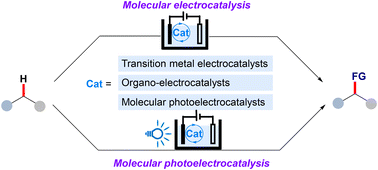Selective functionalization of inert C(sp3)–H bonds remains a central challenge in modern organic synthesis. Molecular electrocatalysis provides a sustainable platform for C(sp3)–H activation by enabling catalyst-controlled electron transfer or atom transfer under mild conditions. This review highlights recent advances in molecular electrocatalytic systems, including both transition metal-based and metal-free catalysts, for efficient C(sp3)–H functionalization. Mechanistic insights into outer- and inner-sphere electron transfer pathways are discussed, along with their applications in enhancing regio- and enantioselectivity in asymmetric radical transformations. Special emphasis is placed on emerging photoelectrocatalytic approaches that integrate electrochemical redox control with photochemical excitation. Through critical evaluation of representative systems, this review illustrates the growing potential of molecular electrocatalysis for achieving selective and sustainable C(sp3)–H functionalization.
